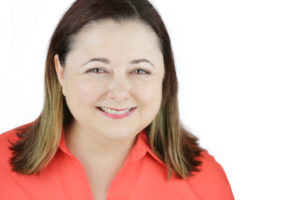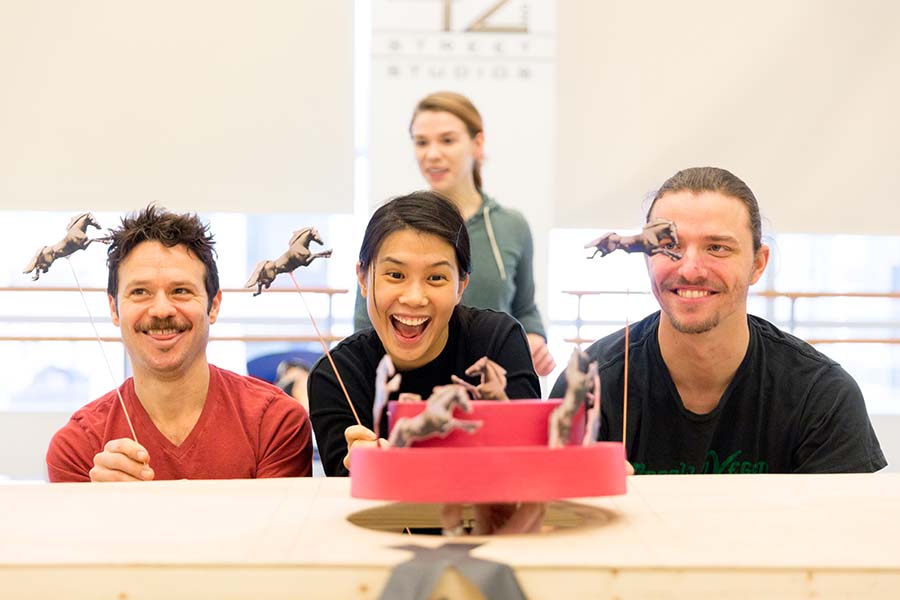When New York’s New Victory Theater presented the Acrobuffos’s show Air Play this past spring, it was the culmination of a process that had come full circle. A circus-inspired visual poem with moving sculpture, Air Play had been developed in part through the New Victory’s LabWorks program, and was now a part of the theatre’s mainstage season. This year, the New Victory will present Spellbound Theatre’s The World Inside Me, another piece developed through LabWorks. This kind of progression from development to production wouldn’t be unusual at most theatre companies—except that the New Victory is a presenting organization, not a producer, and the projects they’re supporting, like everything else they present, are all for young audiences.
While there are several active new-works initiatives in the theatre for young audiences (TYA) world right now, the canon of high-quality TYA work is still relatively small. TYA touring companies continue to earn less on the road than their adult or general audience counterparts, and original content is often passed over for more well-known titles. In this challenging environment, the New Victory is giving artists considerable resources to develop American work for young audiences that is innovative, of high artistic caliber, and ideally tour-able.

Launched in 2012, New Victory LabWorks began as both a means to build community among TYA artists and to cultivate more high-quality American work in this field. “We heard an interest [from artists] in wanting to better understand what TYA is or can be,” says Mary Rose Lloyd, New Victory’s director of artistic programming. “Meanwhile, we also saw a lack of American work in the international touring circuit and knew we were equipped to change that.”
LabWorks artists receive a stipend, free rehearsal space at the New 42nd Street Studios, professional development opportunities, mentorship from New Victory staff, and the chance to hold open rehearsals for New Victory member families, where they can receive feedback from kids and parents. Between eight and 10 projects are selected each year, all in various phases of development. Some notable artists who’ve developed work with LabWorks include the Civilians, Taylor Mac, and Phantom Limb Company. Scottish performer/creator Andy Manley has also been involved in leading workshops for NYC-based artists since the LabWorks program was created.
“Everyone is at a different stage, and that’s sort of the beauty of it,” says artistic programming manager Olga Putilina. “We don’t prescribe. They run the gamut of ‘we’re almost ready to put this in front of people’ to ‘we’re just going sit down in the studio and write for a week.’”
Artists are selected through an application process, and the New Victory artistic team aims to include a range of genres, subject matter, and target age ranges in a given LabWorks season. Airplay and The World Inside Me notwithstanding, whether a project is a good fit for the New Victory stage isn’t a major factor in the selection process.
“It is our hope that these shows eventually make it to full production, but that is not a big deciding factor, nor do we select projects to suit our own artistic programming needs,” says Lloyd. “Rather, we are encouraging work that has sincere intent, cultural relevance and urgency, good stories, cool puppets, and new and surprising ideas—any and all of which are conceived from the outset to be able to tour. We ultimately want this work, these American perspectives, to get out into the world. If they come back to the New Victory at some point, that’s great.”

One of the most notable aspects of the LabWorks residency is the flexibility it gives to its artists. This past season Christopher Anselmo and Jared Corak developed Fountain, a musical about a Florida girl searching for the fountain of youth in order to save her grandfather. During their residency the team developed the piece from a rough concept into a full first draft with music. “We’ve been able to set our own deadlines throughout our time here and create personal goals to help us continue to develop the piece,” says Corak, “One of the best things about LabWorks is that there aren’t set expectations of what we need to use the space for.”
Putilina agrees that giving artists a blank slate is one of the program’s strengths. “We’re not going to require anything specific of anyone or that they be at a certain developmental stage,” she says, “but we are going to ask everyone to share something and get some sort of feedback whether that’s industry or member families or both.”
Anselmo and Corak found their open rehearsal sessions, where actors performed a staged reading of the draft, extremely useful. “Most of the people who have seen it now don’t know us, so it’s been great to have people come in totally blind,” says Amselmo. Putilina emphasizes how each project determines the format of the feedback process. “We have tailored feedback sessions for every open rehearsal, led by teaching artists, and hearing some of the comments is always the most gratifying part,” she says.
For Fountain, the New Victory asked member families how they would describe the show to a friend, what their favorite locations in the show were, and what questions they had about the show and the characters. One child wrote that she loved the show’s mix of sadness and humor, while another questioned a major plot point.
“The whole play is exploring how this girl’s grandfather is struggling with this poetic version of dementia or Alzheimer’s, which is exemplified through these leaks in their house, and the water keeps rising,” Anselmo explains. “After one of our open rehearsals, a young girl asked, ‘If the water was rising, why didn’t he just open the door?’ Those incredibly logical responses were really amazing to hear.”
LabWorks’ professional development and community-building opportunities are also considerable. These include invitations to New Victory performances, workshops, and networking events, some of which have led to further collaborations between LabWorks alumni as well as with international artists on the New Victory mainstage.
“LabWorks is different from other new-work development programs in that the New Victory is a lens to the global TYA field,” says Lloyd. “As presenters, we showcase a variety of artistic disciplines and traditions from all over the world, so in creating LabWorks we want American artists to be inspired and challenged to consider how their stories can be told differently and across multiple art forms.”
Anselmo and Corak have taken full advantage of these opportunities, including a tour of fellow LabWorks artists AchesonWalsh Studios’s workspace in Brooklyn. “We kept looking around their studio and saying, ‘That’s possible?’ ‘You can do that with a puppet?’” says Corak. “Getting to learn from other artists’ expertise and having those spark conversations that inspire what you’re creating, it’s an inspiring environment to be a part of.”

(Photo by Alexis Buatti-Ramos)
While the LabWorks selection process does not heavily weigh a project’s likelihood to see a full production, the program has a solid track record. Out of 34 past LabWorks projects, 19 have received full productions, and two have been programmed at the New Victory.
“I remember when Acrobuffos had their LabWorks residency and seeing them learn how to tour their show and bring it all over the world, and then to have us present it was a really great moment,” says Putilina. “In America, it’s more standard to sit down with a large-scale production, but one of the things that we’re talking to artists about is how you can have a beautiful show that doesn’t necessarily require a whole lot and tour. It can be a suitcase show and still be wonderfully, poetically presented. We’re hoping that’s one of the things artists carry forward from LabWorks, and that that becomes more standard in this country.”
Crucially, LabWorks has demonstrated the value and possibilities of TYA to artists who might not have otherwise explored it. “I think a lot of people assume that writing a TYA show is somehow easier,” says Anselmo, “but the New Victory is holding artists to these standards and making sure our work for all audiences is as good as our work for adult audiences.” Adds Corak, “We’re trying to tackle topics in this piece that are difficult to talk about and process, and that we can encourage families to think and talk about them is really special. No one here has ever once said, ‘This is going too far.’”
Putilina sees LabWorks’ work on this front as part of a larger social project. “Our culture doesn’t fully value artists or children, and by helping create really good work for children, we’re helping to elevate things in both ways,” she says. “It’s exciting to have that mix of people who are fresh, and this is maybe the first work that they are developing ever, and then seasoned artists who have been making work for ages and this is their first time making work for young audiences.”
As funding for both the arts and education remains tight, programs like LabWorks that give artists the gifts of space, time, and mentorship offer a viable solution for presenters looking to expand their seasons and provide service to the field. “I hope that LabWorks can serve as a model of what presenters who don’t produce can do to support local artists,” says Lloyd. “Just opening our doors to artists, both those that have experience with creating work for young audiences and those that never have, helps bridge the understanding that there are wonderful, creative, high-quality, sophisticated possibilities in making great work, and a whole world of touring opportunities waiting for new work, including venues and agents/managers who are looking for this type of work to fill their houses and rosters.”
Presenters, take note: You can help create new work without becoming a producer, and be part of an international community without ever leaving the building.


